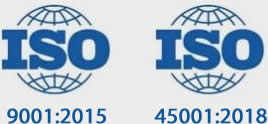The Bruker Dimension Icon is a high-performance Atomic Force Microscope (AFM) designed for advanced nanoscale research. It offers high-resolution imaging, low drift, and noise levels, making it ideal for a wide range of applications. The system supports various imaging modes and techniques, including PeakForce Tapping for nanomechanical mapping.
General specifications :
- XY Scan Range: 90 μm x 90 μm
- Z Range: 7 μm
Microscope Optics:
- Digital Camera: 5 Megapixel
- Viewing Area: 180 μm–1465 μm
Operational in environment, up to 85 dBC continuous acoustic noise
Sample size up to 210 mm in diameter and ≤ 15 mm thick can be accommodated on the rotatable vacuum chuck.
The following imaging modes are available in AFM2: Bruker Dimension Icon:
Tapping mode: The cantilever oscillates near its resonance frequency, and the tip intermittently contacts the sample surface. In addition to topography, this mode can provide phase image of the sample. Phase image shows the phase lag between the oscillating probe and the drive signal. The phase lag is influenced by material properties like adhesion, viscoelasticity, and stiffness. Hence phase imaging can be used for distinguishing between different materials on the surface. It provides contrast based on material properties that are not visible in topography images alone.
Contact mode: The probe is in constant contact with the sample, providing high-resolution topographical images but can damage the soft samples. In force-distance spectroscopy of this mode, the tip approaches and retracts from the sample surface while measuring the vertical deflection of the cantilever. This generates force-distance curves that can be analysed to get information about the sample’s mechanical properties.
Scan Asyst mode: This mode is based on PeakForce Tapping, in which the AFM tip makes intermittent contact with the sample at a controlled frequency, applying a precise force to the sample surface. Unlike the Tapping Mode, which indirectly controls the force through oscillation amplitude, the applied peak force is directly controlled in this mode. In addition, the automatic adjustment of the imaging parameters like- setpoint, scan rate, and feedback gains in real time to optimize the imaging conditions makes it easier to use and provides consistent, high-quality topographical image.
Torsional Resonance Mode(TR Mode): To measure the lateral forces between the probe and the sample, which provides information about frictional properties and in-plane anisotropy. This mode is used for imaging topography, studying material properties, and characterizing 2D materials and heterostructures.
Peak Force Quantitative Nanomechanical Mapping (PFQNM): This mode is based on the Peak Force Tapping. It is used to map the mechanical properties like modulus, adhesion and dissipation while simultaneously imaging the topography of the sample. It is non-destructive and provides high-resolution data.
Lateral Force Microscopy (LFM): In this mode, the AFM tip is in constant contact with the sample surface. It measures the frictional force between the AFM tip and the sample by detecting the lateral deflection of the cantilever. Those mode is particularly useful for studying materials with anisotropic properties and for mapping variations in friction and adhesion across the sample.
Electrostatic Force Microscopy (EFM): This mode obtains the topography as well as the surface charge distribution of the sample by scanning tapping mode and lift mode. It first scans the sample surface in tapping mode to obtain topography and then the tip is lifted to predefined height above the sample surface. At the lifted height the scans the sample while applying the voltage to measure the electrostatic force between the tip and sample. Since the surface topography shapes the electric field gradient, significant differences in topography can obscure true variations in the field source. EFM is most effective with samples that have relatively smooth topography. Suitable field sources include trapped charges and applied voltages, and samples with insulating layers over conducting regions are also ideal for EFM.
Amplitude Modulated Kelvin Force Probe Microscopy (AM-KPFM): This mode measures the contact potential difference between the tip and the sample by nullifying the electrostatic force. It provides the topography as well as the quantitative results of local surface potential distribution from which the work function of the sample can be calculated.
Magnetic Force Microscopy (MFM): MFM using lift mode enables the imaging of weak, long-range magnetic interactions while minimizing topographical influence. The technique involves two scanning passes: the first acquires topographical data in TappingMode, and the second, at a predefined lift height, detects magnetic interactions. This method ensures that topographical features are virtually absent from the resulting MFM image, providing a clearer representation of magnetic properties.
Piezo Force response Microscopy (PFM): PFM is used to study the piezoelectric and ferroelectric domains. Vertical PFM images domains perpendicular to the surface, while horizontal PFM images domains parallel to the surface.
| Technique | Details Required |
| KPFM | Mode: AM KPFM/FM KPFM |
| C-AFM | Voltage to be applied on the sample (Mandatory for current mapping) |
| PFM | Mode (OFF resonance/Contact resonance/DART) Voltage for PFM spectroscopy (switching voltage) Voltage for Box-in-Box (if required) |
| Nano Indentation / PFQNM | Expected Young’s modulus value: (Mandatory for cantilever selection) |
| Nano Lithography | Specify type (Scratch lithography/Oxidation lithography)
Voltage for anodic oxidation lithography Expected scratch depth |
| MFM | Lift height: (If not specified, recommended lift height of 100 nm will be used; range: 30 nm to 150 nm) |
| Liquid Imaging | Mode (Contact/Tapping/Peak Force Tapping/PFQNM)
Liquid medium: (DI water assumed unless specified) |






